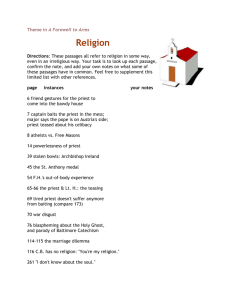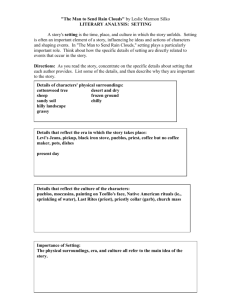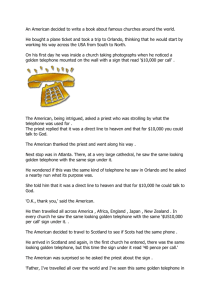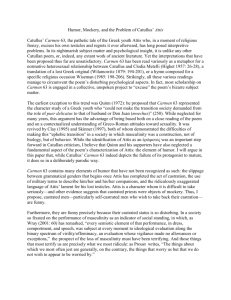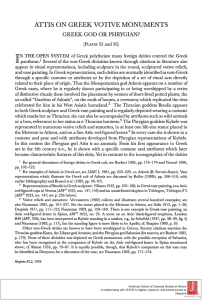TAUROBOLIUM, the sacrifice of a bull, usually in
advertisement
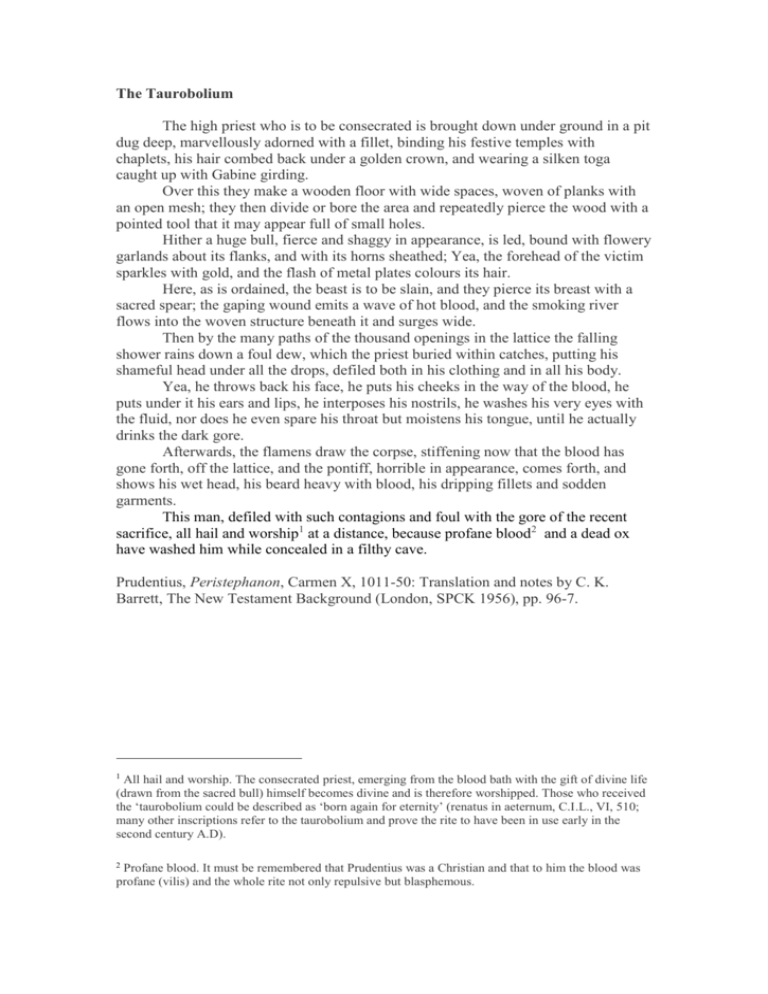
The Taurobolium The high priest who is to be consecrated is brought down under ground in a pit dug deep, marvellously adorned with a fillet, binding his festive temples with chaplets, his hair combed back under a golden crown, and wearing a silken toga caught up with Gabine girding. Over this they make a wooden floor with wide spaces, woven of planks with an open mesh; they then divide or bore the area and repeatedly pierce the wood with a pointed tool that it may appear full of small holes. Hither a huge bull, fierce and shaggy in appearance, is led, bound with flowery garlands about its flanks, and with its horns sheathed; Yea, the forehead of the victim sparkles with gold, and the flash of metal plates colours its hair. Here, as is ordained, the beast is to be slain, and they pierce its breast with a sacred spear; the gaping wound emits a wave of hot blood, and the smoking river flows into the woven structure beneath it and surges wide. Then by the many paths of the thousand openings in the lattice the falling shower rains down a foul dew, which the priest buried within catches, putting his shameful head under all the drops, defiled both in his clothing and in all his body. Yea, he throws back his face, he puts his cheeks in the way of the blood, he puts under it his ears and lips, he interposes his nostrils, he washes his very eyes with the fluid, nor does he even spare his throat but moistens his tongue, until he actually drinks the dark gore. Afterwards, the flamens draw the corpse, stiffening now that the blood has gone forth, off the lattice, and the pontiff, horrible in appearance, comes forth, and shows his wet head, his beard heavy with blood, his dripping fillets and sodden garments. This man, defiled with such contagions and foul with the gore of the recent sacrifice, all hail and worship1 at a distance, because profane blood2 and a dead ox have washed him while concealed in a filthy cave. Prudentius, Peristephanon, Carmen X, 1011-50: Translation and notes by C. K. Barrett, The New Testament Background (London, SPCK 1956), pp. 96-7. 1 All hail and worship. The consecrated priest, emerging from the blood bath with the gift of divine life (drawn from the sacred bull) himself becomes divine and is therefore worshipped. Those who received the ‘taurobolium could be described as ‘born again for eternity’ (renatus in aeternum, C.I.L., VI, 510; many other inscriptions refer to the taurobolium and prove the rite to have been in use early in the second century A.D). 2 Profane blood. It must be remembered that Prudentius was a Christian and that to him the blood was profane (vilis) and the whole rite not only repulsive but blasphemous. TAUROBOLIUM, the sacrifice of a bull, usually in connexion with the worship of the Great Mother of the Gods, though not limited to it. Of oriental origin, its first known performance in Italy occurred in A.D. 134, at Puteoli, in honour of Venus Caelestis. Prudentius describes it in Peristephanon (x., 1066 ff.): the priest of the Mother, clad in a toga worn cinctu Gabino, with golden crown and fillets on his head, takes his place in a trench covered by a. platform of planks pierced with fine holes, on which a bull, magnificent with flowers and gold, is slain. The blood rains through the platform on to the priest below, who receives it on his face, and even on his tongue and palate, and after the baptism presents himself before his fellow-worshippers purified and regenerated, and receives their salutations and reverence. The taurobolium in the 2nd and 3rd centuries was usually performed as a measure for the welfare of the Emperor, Empire, or community, its date frequently being the 24th of March, the Dies Sanguinis of the annual festival of the Great Mother and Attis. In the late 3rd and the 4th centuries its usual motive was the purification or regeneration of an individual, who was spoken of as renatus in aeternum, reborn for eternity, in consequence of the ceremony (Corp. Insc. Lat. vi. 510-512). When its efficacy was not eternal, its effect was considered to endure for twenty years. It was also performed as the fulfilment of a vow, or by command of the goddess herself, and the privilege was limited to no sex nor class. The place of its performance at Rome was near the site of St Peter's, in the excavations of which several altars and inscriptions commemorative of taurobolia were discovered. The taurobolium was probably a sacred drama symbolizing the relations of the Mother and Attis (q.v.). The descent of the priest into the sacrificial foss symbolized the death of Attis, the withering of the vegetation of Mother Earth; his bath of blood and emergence the restoration of Attis, the rebirth of vegetation. The ceremony may be the spiritualized descent of the primitive oriental practice of drinking or being baptized in the blood of an animal, based upon a belief that the strength of brute creation could be acquired by consumption of its substance or contact with its blood. In spite of the phrase renatus in aeternum, there is no reason to suppose that the ceremony was in any way borrowed from Christianity. See Esperandieu, Inscriptions de Lectoure (1892), pp. 94 ff.; Zippel, Festschrift zum Doctorjubilaeum, Ludwig Friedlander, 1895, p. 489 f.; Showerman, The Great Mother of the Gods, Bulletin of the University of Wisconsin, No. 43, pp. 280-84 (Madison, 1901); Hepding, Attis, Seine Mythen and Sein Kult (Giessen, 1903), pp. 168 ff., 201; Cumont, Le Taurobole et le Culte de Bellone, Revue d'histoire et de litterature religieuses, vi., No. 2, 1901. (G. SN.) Encyclopædia Britannica 1911 http://www.theodora.com/encyclopedia/t/taurobolium.html
